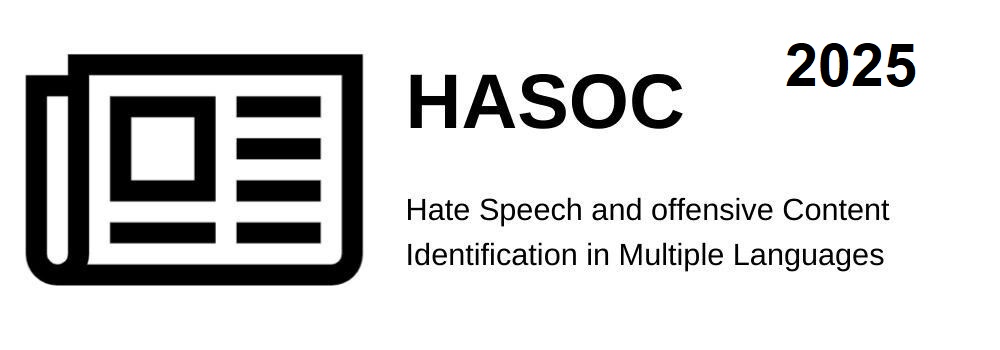
HASOC-meme (2025)
Hate Speech and Offensive Content Identification in Memes in Bangla, Hindi, Gujarati and Bodo

Hate Speech and Offensive Content Identification in Memes in Bangla, Hindi, Gujarati and Bodo
Overview
Overview
Social networking platforms such as Twitter and Facebook have become widely popular due to their ease of use and broad accessibility, offering individuals a powerful space to express their thoughts. Users from all age groups actively engage on these platforms, frequently documenting and sharing details of their daily lives, which contributes to an ever-growing volume of user-generated content. Despite the many advantages of social media, it is not without its drawbacks. A significant amount of harmful and offensive content—including hate speech—circulates online, posing serious societal challenges. Offensive expressions, including derogatory, insulting, or obscene remarks aimed at others and visible to the public, erode the quality of meaningful dialogue. Such language is increasingly prevalent on digital platforms and often intensifies polarization in public debates. According to Habermas (1984), forming public opinion requires rational and critical discourse. Therefore, the presence of toxic content online can undermine democratic processes. At the same time, democratic societies must navigate how to respond to such issues without resorting to excessive censorship. In response, many social media platforms have begun to actively monitor the content shared by users. This shift has created a growing need for automated systems capable of detecting and flagging potentially harmful or suspicious posts. As a result, online communities, tech companies, and social media organizations are heavily investing in tools and technologies aimed at identifying and managing offensive language to foster safer digital environments.
The task of hate speech detection increasingly necessitates the analysis of multimodal data, as harmful online content often exploits the combination of text and images to convey hateful messages in subtle or coded forms. In many instances, the textual content alone may appear innocuous, devoid of any explicit indicators of hate or offense. Similarly, an accompanying image, when viewed in isolation, might seem harmless or ambiguous. However, when these two modalities are presented together, they can create a composite message that is both powerful and deeply offensive. This strategic use of multimodal cues enables malicious users to bypass traditional moderation filters that rely solely on textual analysis. Analyzing both textual and visual content concurrently enables a more comprehensive understanding of the context in which hate speech is embedded. Multimodal analysis allows for the detection of nuanced or implicit hateful messages that might otherwise go unnoticed. For instance, certain images may evoke cultural or political connotations that, when paired with suggestive text, communicate discriminatory, xenophobic, or violent ideologies. In this context, the fusion of modalities serves not just as a medium of communication but as a means of concealing intent under layers of interpretation. Therefore, developing systems that can effectively process and interpret multimodal inputs is essential for the accurate detection of online hate speech. Such systems can significantly enhance the reliability and precision of content moderation tools, ensuring that offensive content is identified and addressed in a timely manner. This is crucial for fostering safer and more inclusive digital spaces. By mitigating the spread of toxic, harmful, and hateful material across social media platforms and online communities, multimodal hate speech detection contributes to the broader goal of preserving democratic discourse, user well-being, and societal harmony in the digital age.